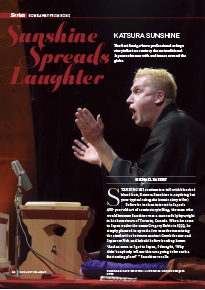Home > Highlighting JAPAN >Highlighting Japan August 2015>Home away from home
Highlighting JAPAN

Home away from home
Katsura Sunshine
Sunshine Spreads Laughter
The first foreign-born professional rakugo storyteller in a century shares traditional Japanese humor with audiences around the globe.

Standing 182 centimeters tall with bleached blond hair, Katsura Sunshine is anything but your typical rakugoka (comic storyteller).
Before he took an interest in Japan’s 400-year-old art of comic storytelling, the man who would become Sunshine was a successful playwright in his hometown of Toronto, Canada. When he came to Japan under the name Gregory Robic in 1999, he simply planned to spend a few months examining the similarities between ancient Greek theater and Japanese Noh and kabuki before heading home. “And as soon as I got to Japan, I thought, ‘Why didn’t anybody tell me this was going to be such a fascinating place?’ ” Sunshine recalls.
He’s hardly left since. Yet when he found his calling years later, it wasn’t in a theater, but at a yakitori shop near his apartment in Yokohama, where the owner invited him to a rakugo performance after closing one day. “I’d never heard of rakugo, but I went,” Sunshine says. “And that just hit me, like, ‘This is it. This is what I was born to do.’ ”
In 2008, Kamigata Rakugo Association President Katsura Sanshi took Sunshine in. As per tradition, he was granted a part of his master’s stage name as his own, becoming Katsura Sunshine. When he completed his apprenticeship three years later, Sunshine became the first foreign-born professional rakugoka in nearly a century, and the first ever non-Japanese to be trained in Osaka’s kamigata style.
A rakugo performance will typically open with a makura—literally, “pillow”—during which the storyteller offers observational jokes much in the style of Western stand-up comedy. The makura often acts as a subtle setup for the central story, which might begin with no more warning than a knock at the door punctuated by the kon-kon-kon rapping of the storyteller’s sensu fan. The rakugoka creates characters with tightly controlled body language and deft shifts in vocal tone, becoming a form of one-man theater.
Sunshine had approached Sanshi (now called Bunshi) because he saw how his master’s vast repertoire of over two hundred original shinsaku rakugo tales might easily be performed in English, and he wasted no time in translating a number of stories and trying them out abroad.
“My first performance as a professional was my master’s story, in English, in Singapore,” Sunshine explains. “So I’m maybe the first storyteller in the 400-year history of the art form who did his first professional performance abroad—and certainly in English.”
His performances have been lauded domestically and abroad ever since. In 2013, Sunshine toured twenty cities in Canada and the U.S., and last year he delivered twenty-five performances at the U.K.’s Edinburgh Festival Fringe. He’s been described as a “one-man sitcom” by CTV TV Montreal in Canada, while the U.K.’s Edinburgh Evening News declared, “Sunshine has them laughing in the aisles!”
Sunshine insists that, aside from language, there’s no need to alter rakugo to appeal to a foreign audience. “People get it,” he says. “You don’t want to take out the Japanese aspects. You want to keep as much Japanese in it as possible when you do it abroad. That’s part of the cachet.” He often spends much of his makura time regaling audiences with the struggles of his apprenticeship and his difficulties with Japanese vocabulary.
“I’m hooked on performing abroad,” Sunshine declares with his indelible smile, every word delivered at the same breakneck speed he employs onstage. “People just love it.” As he spends 2015 on a world tour that will see him entertaining audiences in Australia, Hong Kong, Thailand, Europe and even Africa, he certainly doesn’t show any signs of slowing down.
© 2009 Cabinet Office, Government of Japan






